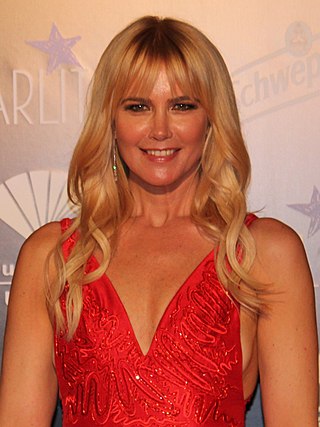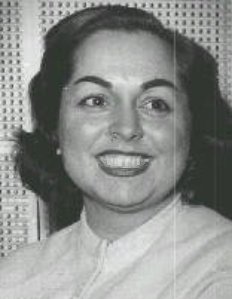Related Research Articles

Valeria Raquel Mazza is an Argentine model and businesswoman. Mazza rose to prominence in the 1990s and became a household name after appearing on the cover of the Sports Illustrated Swimsuit Issue of 1996 alongside Tyra Banks. Mazza worked for fashion designers such as Gianni Versace and Roberto Cavalli.

Olga Zubarry was a Argentine actress who appeared in film between 1943 and 1997. She made over 60 appearances in film, spanning six decades of Argentine cinema, but is best known for her work during the Golden Age of Argentine Cinema. Throughout the course of her career, she received four Silver Condor Awards, two Martín Fierro Awards, a Konex Foundation Award and several others for her films and television performances. She is credited with starring in the first film in Argentina which featured nudity, though only her back was shown and she stated repeatedly that she wore a flesh-colored mesh and was not truly nude.
Jorge Glusberg was an Argentine author, publisher, curator, professor, and conceptual artist.

Zulema Esther González Borbón, better known as Zully Moreno, was an Argentine film actress of the Golden Age of Argentine Cinema (1940–1960). She appeared in more than 70 movies, earning best actress awards from the Argentine Academy of Motion Picture Arts and Sciences and the Spanish Cinema Writers Circle.

Elva "Chunchuna" Villafañe is an Argentine model, actress and architect, born in Buenos Aires, Argentina.

María Eugenia Suárez Riveiro, better known as China Suárez, is an Argentine actress, singer and model.

Nélida Dodó López Valverde known professionally as Nelly Beltrán was an Argentine actress. She appeared on the radio from the age of 10 and in 85 theatrical performances, 48 films and 3 dozen television shows between 1953 and 1996. She won a Martín Fierro Award as Best Comic Actress for her television work on La hermana San Sulpicio; participated in the film Pajarito Gómez which won the Best Youth Film award at the 15th Berlin International Film Festival; won a Konex Foundation Award; and was honored by the Argentina Actors Association in 2004 for her career contributions.

Claudia Alejandra Menkarski, known as Claudia Brant, is an Argentine composer, producer and singer in diverse genres and multiple languages.

Claudia Fabiana Fernández Viera is a Uruguayan award-winning television presenter, fashion model, actress and businesswoman. Born in Punta de Rieles – Bella Italia, Montevideo she began her career as a model in her teens and participated in numerous advertising campaigns. In the late 1990s, she began working on television, on the show Dale que Podés. She also participated in the reality show Bailando por un Sueño, and in the talk show Animales Sueltos, both in Argentina.

Sabina Olmos (1913–1999) pseudonym of Rosa Herminia Gómez Ramos was an Argentine film actress of the Golden Age of Argentine Cinema (1940–1960).

Elvira Travesí was an Argentinean actress.

El corazón nunca se equivoca is a Mexican television series produced by Juan Osorio for Televisa that premiered on Las Estrellas on 23 June 2019 and ended on 26 July 2019. The series stars Emilio Osorio and Joaquín Bondoni. It is a spin-off of the telenovela Mi marido tiene familia.

Betty Elizalde was an Argentine journalist and broadcaster. She won the Konex Award in 1981.

Amalia Granata is an Argentine model and politician. She became a congresswoman for Santa Fe Province in 2019.

María Onetto was an Argentine theatre, film, and television actress. She received the a 2011 Konex Award in entertainment for her theatrical work, and is also well known for her role in the 2006 Argentine TV series Montecristo, for which she won the Clarín and Martín Fierro Awards as best actress in drama and rising star. She also directed a localized production of rock musical Passing Strange in 2011.

Claudia Rosana Villafañe is an Argentine businesswoman and producer, known for being Diego Maradona's wife and the winner of the first MasterChef Celebrity Argentina edition.
Liliana Caldini was an Argentine model, actress, and television show host.

María Duval was an Argentine actress, considered one of the most representative performers of the Argentine cinema of the 1940s. She made 21 films until her retirement in 1949.

María Josefa Álvarez de Arenales was a patriot who, at a young age, contributed financially to the Argentine War of Independence. She is considered one of the Patricias Argentinas. She married her second cousin, Colonel Evaristo de Uriburu, with whom she had many children; among them was José Evaristo Uriburu, who would become the President of Argentina. Her grandson, General José Félix Uriburu, was later the de facto president of the republic.
Alicia Jurado was an Argentine writer and academic. She spoke English and French, she knew Italian and understood German. Although most of her reading was done in English, rather than in French or Spanish, she wrote her works in the latter language. She was a full member of the Academia Argentina de Letras, a member of the Royal Spanish Academy, and a corresponding member of the Academia Chilena de la Lengua. Jurado was a collaborator and friend of Victoria Ocampo and Jorge Luis Borges.
References
- 1 2 3 "Horrible muerte para Elsa Serrano". laubfal.com (in Spanish). Retrieved 17 September 2020.
- ↑ Centro de Estudios Migratorios Latinoamericanos: "Apellido/Nombre/Edad/Estado Civil/Nacionalidad/Lugar de Nacimiento/Profesión/Fecha de Arribo/Barco/Puerto/ROMIO/ELSA/14/S/ITALIANA/COSENZA/MENOR/1955/12/07/ENTRE RIOS/NAPOLES".
- 1 2 Vidal, Dolores. "Elsa Serrano". Nubilis (in Spanish). Archived from the original on 23 October 2020. Retrieved 18 September 2020.
- 1 2 Larrea, Agustina (11 November 2018). "De dormir en el Kremlin y vestir a las primeras damas a quebrar en 2001 y ser monotributista: la sorprendente vida de Elsa Serrano". infobae (in Spanish). Retrieved 18 September 2020.
- 1 2 Mascareño, Pablo (28 January 2020). "Elsa Serrano: "Me separé hace 23 años y nunca más estuve en pareja "". www.lanacion.com.ar (in Spanish). Retrieved 18 September 2020.
- ↑ "Los vestidos de Elsa Serrano: desde Claudia Villafañe a las figuras del poder". www.lanacion.com.ar (in Spanish). 17 September 2020. Retrieved 18 September 2020.
- ↑ "Quién fue Elsa Serrano, un ícono de la moda argentina | Apodada como "la modista del poder"". Página/12 (in Spanish). 17 September 2020. Retrieved 19 September 2020.
- ↑ Balaguer, Adriana (2012). Hijos del poder : los herederos de la política y el negocio (in Spanish). Aguilar. ISBN 978-987-04-2320-1 . Retrieved 18 September 2020.
- ↑ Lanús, Catalina (16 October 2003). "Elsa Serrano, hoy, como ayer". www.lanacion.com.ar (in Spanish). Retrieved 18 September 2020.
- ↑ "Elsa Serrano: "Yo no llevaba las cuentas, una creadora nunca está en los números"". Diario26. 2 June 2011. Retrieved 18 September 2020.
- ↑ "María Pryor, Lage y Guevara, los grandes ganadores de las Tijeras de Plata". Diario Popular (in Spanish). 12 November 2014. Retrieved 18 September 2020.
- ↑ "Murió Elsa Serrano: se incendió su vivienda en Retiro". La Nación (Argentina). 17 September 2020. Retrieved 17 September 2020.
- ↑ "Confirmado: murió Elsa Serrano al incendiarse su departamento". ambito.com. Retrieved 17 September 2020.